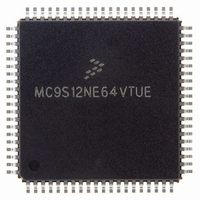MC9S12NE64VTUE Freescale Semiconductor, MC9S12NE64VTUE Datasheet - Page 92

MC9S12NE64VTUE
Manufacturer Part Number
MC9S12NE64VTUE
Description
IC MCU 64K FLASH EEPROM 80-TQFP
Manufacturer
Freescale Semiconductor
Series
HCS12r
Datasheet
1.MC9S12NE64VTU.pdf
(554 pages)
Specifications of MC9S12NE64VTUE
Core Processor
HCS12
Core Size
16-Bit
Speed
25MHz
Connectivity
EBI/EMI, Ethernet, I²C, SCI, SPI
Peripherals
POR, PWM, WDT
Number Of I /o
38
Program Memory Size
64KB (64K x 8)
Program Memory Type
FLASH
Ram Size
8K x 8
Voltage - Supply (vcc/vdd)
2.375 V ~ 3.465 V
Data Converters
A/D 8x10b
Oscillator Type
Internal
Operating Temperature
-40°C ~ 105°C
Package / Case
80-TQFP Exposed Pad, 80-eTQFP, 80-HTQFP, 80-VQFP
Processor Series
S12N
Core
HCS12
Data Bus Width
16 bit
Data Ram Size
8 KB
Interface Type
I2C, SCI, SPI
Maximum Clock Frequency
125 MHz
Number Of Programmable I/os
70
Number Of Timers
4
Operating Supply Voltage
- 0.3 V to + 3 V
Maximum Operating Temperature
+ 105 C
Mounting Style
SMD/SMT
3rd Party Development Tools
EWHCS12
Development Tools By Supplier
EVB9S12NE64E, DEMO9S12NE64E
Minimum Operating Temperature
- 65 C
On-chip Adc
10 bit, 8 Channel
Cpu Family
HCS12
Device Core Size
16b
Frequency (max)
25MHz
Total Internal Ram Size
8KB
# I/os (max)
70
Number Of Timers - General Purpose
4
Operating Supply Voltage (typ)
2.5/3.3V
Operating Supply Voltage (max)
2.625/3.465V
Operating Supply Voltage (min)
2.357/2.375/3.135V
Instruction Set Architecture
CISC
Operating Temp Range
-40C to 105C
Operating Temperature Classification
Industrial
Mounting
Surface Mount
Pin Count
80
Package Type
TQFP
For Use With
EVB9S12NE64E - BOARD EVAL FOR 9S12NE64DEMO9S12NE64E - DEMO BOARD FOR 9S12NE64
Lead Free Status / RoHS Status
Lead free / RoHS Compliant
Eeprom Size
-
Lead Free Status / Rohs Status
Lead free / RoHS Compliant
Available stocks
Company
Part Number
Manufacturer
Quantity
Price
Company:
Part Number:
MC9S12NE64VTUE
Manufacturer:
Freescale Semiconductor
Quantity:
10 000
Part Number:
MC9S12NE64VTUE
Manufacturer:
FREESCALE
Quantity:
20 000
- Current page: 92 of 554
- Download datasheet (4Mb)
Chapter 2 64 Kbyte Flash Module (S12FTS64KV3)
2.4.1.3.2
The data compress command is used to check Flash code integrity by compressing data from a selected
portion of the Flash block into a signature analyzer. The starting address for the data compress operation
is defined by the address written during the command write sequence. The number of consecutive word
addresses compressed is defined by the data written during the command write sequence. The number of
words that can be compressed in a single data compress operation ranges from 1 to 16,384. After launching
the data compress command, the CCIF flag in the FSTAT register will set after the data compress
operation has completed. The number of bus cycles required to execute the data compress operation is
equal to two times the number of addresses read plus 20 bus cycles as measured from the time the CBEIF
flag is cleared until the CCIF flag is set. After the CCIF flag is set, the signature generated by the data
compress operation is available in the FDATA register. The signature in the FDATA register can be
compared to the expected signature to determine the integrity of the selected data stored in the Flash block.
If the last address of the Flash block is reached during the data compress operation, data compression will
continue with the starting address of the Flash block.
In order to take corrective action, it is recommended that the data compress command be executed on a
Flash sector or subset of a Flash sector. If the data compress operation on a Flash sector returns an invalid
signature, the Flash sector must be erased using the sector erase command and then reprogrammed using
the program command.
The data compress command can be used to verify that a sector or sequential set of sectors are erased.
92
Data Compress Command
Since the FDATA register (or data buffer) is written to as part of the data
compress operation, a command write sequence is not allowed to be
buffered behind a data compress command write sequence. The CBEIF flag
will not set after launching the data compress command to indicate that a
command must not be buffered behind it. If an attempt is made to start a new
command write sequence with a data compress operation active, the
ACCERR flag in the FSTAT register will be set. A new command write
sequence must only be started after reading the signature stored in the
FDATA register.
MC9S12NE64 Data Sheet, Rev. 1.1
NOTE
Freescale Semiconductor
Related parts for MC9S12NE64VTUE
Image
Part Number
Description
Manufacturer
Datasheet
Request
R
Part Number:
Description:
Manufacturer:
Freescale Semiconductor, Inc
Datasheet:
Part Number:
Description:
Manufacturer:
Freescale Semiconductor, Inc
Datasheet:
Part Number:
Description:
Manufacturer:
Freescale Semiconductor, Inc
Datasheet:
Part Number:
Description:
Manufacturer:
Freescale Semiconductor, Inc
Datasheet:
Part Number:
Description:
Manufacturer:
Freescale Semiconductor, Inc
Datasheet:
Part Number:
Description:
Manufacturer:
Freescale Semiconductor, Inc
Datasheet:
Part Number:
Description:
Manufacturer:
Freescale Semiconductor, Inc
Datasheet:
Part Number:
Description:
Manufacturer:
Freescale Semiconductor, Inc
Datasheet:
Part Number:
Description:
Manufacturer:
Freescale Semiconductor, Inc
Datasheet:
Part Number:
Description:
Manufacturer:
Freescale Semiconductor, Inc
Datasheet:
Part Number:
Description:
Manufacturer:
Freescale Semiconductor, Inc
Datasheet:
Part Number:
Description:
Manufacturer:
Freescale Semiconductor, Inc
Datasheet:
Part Number:
Description:
Manufacturer:
Freescale Semiconductor, Inc
Datasheet:
Part Number:
Description:
Manufacturer:
Freescale Semiconductor, Inc
Datasheet:
Part Number:
Description:
Manufacturer:
Freescale Semiconductor, Inc
Datasheet:











